Energy From the Sun Student Guide





Energy makes change; it does things for us. It moves cars along the road and boats over the water. It bakes a cake in the oven and keeps ice frozen in the freezer. It plays our favorite songs on the radio and lights our homes. Energy makes our bodies grow and allows our minds to think. Scientists define energy as the ability to do work.
Energy is found in different forms, such as light, heat, sound, and motion. There are many forms of energy, but they can all be put into two categories: potential and kinetic.
Potential energy is stored energy or the energy of position, or gravitational energy. There are several forms of potential energy.
Chemical energy is energy stored in the bonds of atoms and molecules. It is the energy that holds these particles together. Biomass, petroleum, natural gas, and propane are examples of stored chemical energy.
Elastic energy is energy stored in objects by the application of a force. Compressed springs and stretched rubber bands are examples of elastic energy.
Nuclear energy is energy stored in the nucleus of an atom; it is the energy that holds the nucleus together. The energy can be released when the small nuclei are combined or large nuclei split apart. Nuclear power plants split the nuclei of uranium atoms in a process called fission. The sun combines the nuclei of hydrogen atoms in a process called fusion.
Gravitational potential energy is the energy of position or place. A rock resting at the top of a hill contains gravitational potential energy. Hydropower, such as water in a reservoir behind a dam, is an example of gravitational potential energy.
Kinetic energy is motion; it is the motion of waves, electrons, atoms, molecules, substances, and objects.
Electrical energy is the movement of electrons. Everything is made of tiny particles called atoms. Atoms are made of even smaller particles called electrons, protons, and neutrons. Applying a force can make some of the electrons move. Electrons moving through a wire are called electricity. Lightning is another example of electrical energy.
Radiant energy is electromagnetic energy that travels in transverse waves. Radiant energy includes visible light, x-rays, gamma rays, and radio waves. Solar energy and light are examples of radiant energy.
Thermal energy, or heat, is the internal energy in substances; it is the vibration and movement of the atoms and molecules within substances. The more thermal energy in a substance, the faster the




atoms and molecules vibrate and move. Geothermal energy is an example of thermal energy.
Motion energy is the movement of objects and substances from one place to another. Objects and substances move when an unbalanced force is acting on them, according to Newton’s Laws of Motion. Wind is an example of motion energy.
Sound energy is the movement of energy through substances in longitudinal (compression/rarefaction) waves. Sound is produced when a force causes an object or substance to vibrate. The energy is transferred through the substance in a longitudinal wave.
The Law of Conservation of Energy is not about saving energy, like it may sound. This law states that energy is neither created nor destroyed. However, it can change from one form to another. Energy does not disappear, it is converted.
A car engine, for example, burns gasoline, converting the chemical energy in the gasoline into useful motion energy. Some of the energy is also converted into light, sound, and heat. Photovoltaic (solar) cells convert radiant energy into electrical energy. Energy changes form, but the total amount of energy in the universe remains the same.
Energy efficiency is the amount of useful energy you get from a system. A perfect energy efficient machine would convert all of the energy put into it into useful work, which is technologically impossible at this time. Converting one form of energy into another form always involves a loss of usable energy—usually in the form of heat—from friction and other processes. This “waste heat’” dissipates quickly and is very difficult to recapture.
Typical coal-fired, natural gas, biomass, and nuclear power plants convert about 30 to 35 percent of the heat they produce into electricity. A hydropower plant, on the other hand, converts about 95 percent of the kinetic energy in the water flowing through the system into electricity. Solar technologies are usually between 18-30 percent efficient. Most energy transformations are not very efficient. For example, a typical car converts only about 15 percent of the gasoline used into work. The human body is another example of a low efficiency “machine.” Your body’s fuel is food. Food gives you the energy to move, breathe, and think. Your body is very inefficient at converting food into useful work. Most of the energy in your body is released as heat.
We use many different sources to meet our energy needs every day. They are usually classified into two groups—renewable and nonrenewable.
In the United States, most of our energy comes from nonrenewable energy sources. Coal, petroleum, natural gas, propane, and uranium are nonrenewable energy sources. They are used to make electricity, heat our homes, move our cars, and manufacture all kinds of products. These sources are called nonrenewable because their supplies are limited. Petroleum, for example, was formed hundreds of millions of years ago, before dinosaurs existed, from the remains of ancient sea plants and animals. Fossil fuels, like petroleum, cannot be made quickly.
Renewable energy sources include biomass, geothermal energy, hydropower, solar energy, and wind energy. They are called renewable because they are replenished in a short time. Day after day, the sun shines, the plants grow, the wind blows, and the rivers flow. We use renewable energy sources mainly to make electricity.
The energy sources discussed so far are known as primary sources. Electricity is known as a secondary energy source because it must be produced from a primary source. For example, the heat from burning coal, a primary energy source, produces steam, which turns turbines to generate electricity. Electricity is sometimes called an energy carrier because it is an efficient and safe way to move energy from one place to another, and it can be used for many tasks. As we use more technology, the demand for electricity grows.
Electricity is different from the other energy sources because it is a secondary source of energy. We must use another energy source to produce electricity. In the U.S., natural gas is the number one energy source used for generating electricity.
NONRENEWABLE, 87.5%
RENEWABLE, 12.4%
Petroleum 34.7%
Uses: transportation, manufacturing - Includes Propane
Natural Gas 34.0%
Uses: electricity, heating, manufacturing - Includes Propane
Biomass 4.9%
Uses: electricity, heating, transportation
Wind 3.2%
Uses: electricity
Coal 9.9%
Uses: electricity, manufacturing Uranium 8.9%
Uses: electricity
*Propane consumption gures are reported as part of petroleum and natural gas totals.
Propane
Uses: heating, manufacturing
Data: Energy Information Administration
Hydropower 2.8%
Uses: electricity
Solar 1.3%
Uses: electricity, heating
Geothermal 0.2%
Uses: electricity, heating
*Total does not equal 100% due to independent rounding.
Data: Energy Information Administration
*Total does not equal 100% due to independent rounding.

RENEWABLES
WIND, 8.4%
HYDROPOWER, 7.1%
SOLAR, 2.3%
BIOMASS, 1.4%
GEOTHERMAL, 0.4%
Electricity is sometimes called an energy carrier because it is an efficient and safe way to move energy from one place to another, and it can be used for so many tasks. As we use more technology, the demand for electricity grows.
Every day, the sun radiates (sends out) an enormous amount of energy. It radiates more energy each day than the world uses in one year. Solar energy is a renewable energy source.
The sun’s energy comes from within the sun itself. Like most stars, the sun is made up mostly of hydrogen and helium atoms in a plasma state. The sun generates energy from a process called nuclear fusion.
During nuclear fusion, the high pressure and temperature in the sun’s core cause nuclei to separate from their electrons. Hydrogen nuclei fuse to form one helium atom. During the fusion process, radiant energy is released. It can take 150,000 years for energy in the sun’s core to make its way to the solar surface, and then just a little over eight minutes to travel the 93 million miles to Earth. The radiant energy travels to the Earth at a speed of 186,000 miles per second, the speed of light.
Only a small portion of the energy radiated by the sun into space strikes the Earth, one part in two billion. Yet this amount of energy is enormous. The sun provides more energy in an hour than the United States can use in a year! About 30 percent of the radiant energy that reaches the Earth is reflected back into space. About half of the radiant energy is absorbed by land and oceans. The rest is absorbed by the atmosphere and clouds in the greenhouse effect
The process of fusion most commonly involves hydrogen isotopes combining to form a helium atom with a transformation of matter. This matter is emitted as radiant energy.
Hydrogen Isotope
Neutron

Hydrogen Isotope
Helium Energy
In addition to supplying a large amount of energy directly, the sun is also the source for many different forms of energy. Solar energy powers the water cycle, allowing us to harness the energy of moving water. Solar energy drives wind formation, allowing us to use wind turbines to transform kinetic energy into electricity. Plants use solar energy in the process of photosynthesis. Biomass can trace its energy source back to the sun. Even fossil fuels originally received their energy from the sun.
People have harnessed solar energy for centuries. As early as the seventh century BCE, people used basic magnifying glasses to focus light from the sun to make fire. Over a century ago, a scientist in France used a solar collector to make steam to power an engine. Solar water heaters gained popularity in the early 1900’s in the southwest United States. Today, people use solar energy to heat buildings and water and to generate electricity. In 2020, solar energy accounted for just over 1.3 percent of U.S. total energy consumption. Solar energy is growing in many of the 50 states, including those that are not always sunny and warm.

Radiant energy (light rays) shines on the Earth. Some radiant energy reaches the atmosphere and is reflected back into space. Some radiant energy is absorbed by the atmosphere and is transformed into heat (dark arrows). Half of the radiant energy that is directed at Earth passes through the atmosphere and reaches the Earth, where it is transformed into heat. The Earth absorbs some of this heat, but most of the heat flows back into the air. The atmosphere traps the heat. Very little of the heat escapes back into space. The trapped heat flows back to the Earth. This is called the greenhouse effect. The greenhouse effect keeps the Earth at a temperature that supports life. 2





A solar collector is one way to capture sunlight and transform it into heat energy, or thermal energy. The amount of solar energy an area receives depends on the time of day, the season of the year, the cloudiness of the sky, and how far one is from the Earth’s Equator. A closed car on a sunny day is a solar collector. As sunlight passes through the car’s windows, the seat covers, side panels, and floor of the car absorb it. The absorbed energy transforms into thermal energy that is trapped inside the car. A greenhouse also makes a great example of a solar collector.
Space heating means heating the space inside a building. Today, many homes use solar energy for space heating. There are two basic types of solar space heating systems: passive and active. Hybrid solar systems are a combination of passive and active systems.
A passive solar home is designed to let in as much sunlight as possible. It is a big solar collector. Sunlight passes through the windows and heats the walls and floor inside the house. The light can get in, but the thermal energy is trapped inside. A passive solar home does not depend on mechanical equipment to move heat throughout the house. For example, awnings may be designed to let in light in the winter when the sun is lower in the horizon, yet shade the windows in the summer when the sun is higher in the sky. Passive solar buildings are quiet, peaceful places to live or work. They do not rely on machinery and heat the walls or floors rather than the air inside. Passive homes can get 30 to 80 percent of the heat they need from the sun. They store their heat energy by using thick walls and building materials that retain heat well like masonry, concrete, stone, and even water. If a passive home incorporates blowers or fans, it is then called a hybrid solar system.
An active solar home uses mechanical equipment and other sources of energy to collect and move thermal energy. One example of an active solar system consists of dark-colored metal plates inside frames with glass tops. These systems are often mounted on the roof or in a location with good solar exposure. The metal plates absorb sunlight and transform it into thermal energy, which heats up a fluid inside the collector. The warmed fluid is moved into the house via a pump and the thermal energy of the fluid is transferred to the air or water inside the home. These solar collectors are stored high on a roof where they can collect the most sunlight. They need to be placed in an area where they will not be shaded by trees or other buildings. Heat can be stored in a large tank filled with liquid, or even in rock bins underneath the house. Both active and passive designs usually include some sort of back-up system like a furnace or wood stove, in case of extreme cold or cloudy weather.
SOLAR
WATER

Solar energy can be used to produce electricity. Two ways to make electricity from solar energy are photovoltaic systems and systems using thermal energy.
Photovoltaic comes from the words photo, meaning light, and volt, a measurement of electricity. Photovoltaic cells are also called PV cells or solar cells for short. Using PV cells to harness the sun’s energy is a rapidly expanding science. The first practical PV cell was developed by Bell Telephone researchers. At first, PV cells were used primarily in space to power U.S. space satellites. Now PV cells are common in many different applications. You are probably familiar with photovoltaic cells. Solar-powered toys, calculators, and many lighted roadside signs all use solar cells to convert sunlight into electricity.
Solar cells are made of a thin wafer of silicon, one of the elements found in sand and the second most common element on Earth. The top of the wafer has a very small amount of phosphorous added to it. This gives the top of the wafer an extra amount of free, negatively charged electrons. This is called n-type silicon because it has a habit of giving up its electrons, a negative character. The bottom of the wafer has a small amount of boron added to it, which has a tendency to attract electrons. It is called p-type silicon because of its positive character. When both of these chemicals have been added to the silicon wafer, some of the free electrons from the n-type silicon flow to the p-type silicon and an electric field forms between the layers at the p-n junction. The p-type now has a negative charge because it gained electrons. The n-type has become positive because it lost electrons.
When the PV cell is placed in the sun, the radiant energy excites the free electrons. If a circuit is made by connecting the wafer’s sides, electrons transfer their energy from atom to atom from the n-type through the wire to the p-type. The PV cell is producing electricity— the transfer of energy due to moving electrons. If a load such as a light bulb is placed along the wire forming a circuit, the electricity will do work as it flows to make the bulb light. The conversion of sunlight into electricity takes place silently and instantly. There are no mechanical parts to wear out, therefore photovoltaic systems last an extended period of time.
Photovoltaic systems can consist of small cells, like the ones that charge calculators, to systems that power individual homes, to large power plants powering many homes. The average size of a residential PV system installed is about 6.1 kilowatts. The average size of a utility-scale PV is about 4.3 megawatts. However, the sizes of residential, commercial, and utility-scale PV systems can vary greatly, depending on the space available for use.
New technologies are constantly being developed to make PV cells thinner and more flexible. There are now roofing shingles that are made of PV cells. Rather than putting panels on your roof, solar shingles can be used that match the conventional shingles for a more pleasing look. Scientists are developing PV cells that can be put into home windows and on thin, flexible film that can be attached to the outside of the home. There are even different types of solar paint!
A loc ation that can accept an elec tron
Free elec tron
Proton
Tightly-held elec tron
STEP 1
STEP 3
POSITIVE CHARGE NEGATIVE CHARGE
STEP 4
n-type silicon
p-type silicon
STEP 2 FREE ELECTRON load
n-type p-type p-n junction
SUN
PHOTONS n-type p-type p-n junction
sun SUN
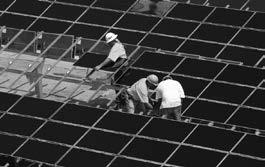
Concentrating solar power (CSP) systems also use solar energy to make electricity, but instead of only panels, they also use a turbine system. Since the solar radiation that reaches the Earth is so spread out, it must be concentrated to produce the high temperatures required to generate electricity using a steam turbine. There are several types of systems that use mirrors or other reflecting surfaces to concentrate the sun’s energy, increasing its intensity.
Linear concentrating systems use mirrors to concentrate sunlight onto receivers located just above the mirrors. The receivers are long tubes that carry either water that is directly converted to steam or fluid that transfers energy in a heat exchanger, which produces steam. The steam drives a turbine that turns a generator to make electricity. Linear concentrating systems are either parabolic trough systems, or linear Fresnel reflector systems.
Parabolic trough systems use long, curved mirrors in troughs that focus the sunlight onto a pipe located at the focal line. A fluid circulating inside the pipe collects the energy and transfers it to a heat exchanger, producing steam to drive a conventional turbine.
One of the word’s largest parabolic trough systems, SEGS, is found in the Mojave Desert in California. The facility consists of several sites that have a total generating capacity of 354 megawatts. Five to ten acres of parabolic troughs are needed to produce one megawatt of electricity. The Solana plant in Arizona can generate 280 megawatts. Afacility in Morocco generates 360 megawatts from its trough system and additional power from power towers and PV systems.
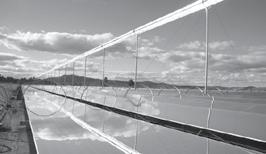


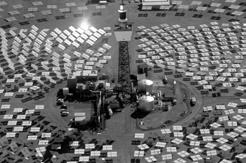
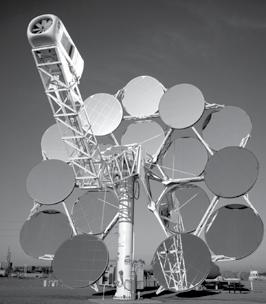
Linear Fresnel reflector systems use several flat mirrors in groups to concentrate the sun onto a tube receiver above them. This arrangement allows the mirrors to better track the sun’s position for maximum reflection. The first linear Fresnel reflector system in the U.S. generates 5 megawatts of electricity in Bakersfield, CA.
While parabolic trough systems are the most common in the United States, there are advantages and disadvantages to both systems. Parabolic trough systems are proven and have excellent performance. However, the parabolic mirrors are expensive to manufacture and the power plants require large amounts of land. Linear Fresnel reflector systems use mirrors that are easier and cheaper to manufacture. However, the performance of linear Fresnel reflector systems does not yet match that of parabolic troughs.
A solar power tower consists of a large field of sun-tracking mirrors, called heliostats, that focus solar energy on a receiver at the top of a centrally located tower. The enormous amount of energy in the sun’s rays focused at one point on the tower can produce temperatures over 500 degrees Celsius. The thermal energy is used for heating water or molten salt that saves the energy for later use. In a heat exchanger, the hot water or molten salt heats the water and changes it to steam that is used to move the turbine generator. The largest solar power tower system in the world is found in California. The Ivanpah Solar Electric Generation System uses three towers with over 170,000 heliostats and has a generating capacity of over 390 megawatts. Dubai is presently constructing a system that will exceed the generation capacity of Ivanpah.
Dish/engine systems are like satellite dishes that concentrate sunlight rather than signals, with a heat engine located at the focal point to generate electricity. These generators can be small, mobile units that can be operated individually or in clusters, in urban and remote locations.
One of the challenges with generating electricity from solar energy is that people consume electricity 24 hours a day, but the sun only shines a portion of that time. One strategy to overcome that challenge is to build a hybrid facility. A hybrid facility is an electric generating plant that uses both renewable and nonrenewable energy sources in order to meet the electrical demand of the local community.
Florida Power and Light Company (FPL) has a combined-cycle natural gas power plant in Indiantown, FL. In 1989, a portion of the site was licensed for a coal-powered generation unit that was not constructed. Instead, ground was broken in 2008 to use 500 acres of the site for a solar-thermal array that transforms the sun’s energy into 75 MW of electricity.
The center uses about 200,000 parabolic mirrors to harness the sun’s energy. Using motors, the mirrors rotate to track the sun and take full advantage of daylight hours. At full peak, estimated electricity generation each year is 155,000 megawatt-hours, enough to power 11,000 homes. This makes the Martin Next Generation Solar Energy Center the largest solar thermal power plant in the eastern United States.
The FPL Martin Next Generation Solar Energy Center is the first hybrid solar facility in the world to connect a solar plant to an existing combined-cycle natural gas power plant. Steam produced by the concentrated solar thermal system is transferred to the same steam turbine that the natural gas plant uses. The electricity generated in this process is then sent out onto the grid through existing transmission lines. Connecting the solar plant to the natural gas plant reduced the cost to build the solar facility. This will allow FPL to reduce its natural gas use by 1.3 billion cubic feet each year, saving customers $178 million in fuel costs over the life of the solar facility. Over its lifetime, the center will also prevent 2.75 million tons of greenhouse gases from entering the atmosphere— the equivalent of removing more than 18,500 cars from the road every year for 30 years.
When constructing any energy facility, engineers and planners must take many things into account. When building the Martin Next Generation Solar Energy Center, plant engineers had to consider Florida’s hurricane season. The motors that move the mirrors also allow the mirrors to flip upside down for protection. The mirrors are built on an advanced aluminum truss system that can sustain winds up to 130 miles per hour.
The FPL Martin Next Generation Solar Energy Center showcases how utilities are bringing all energy sources into their generation plans and finding ways to connect renewable and nonrenewable energy sources to provide the electricity needed night and day.
FPL began construction in 2019 to create additional solar energy centers in Florida. This move is part of their plan to install more than 30 million panels by 2030, and make Florida a world leader in solar energy. FPL aims to have more than 11,700 megawatts of solar capacity by 2030. Construction is nearly 50 percent complete with more than 40 solar energy centers online and operating in FPL territory. The fleet of panels provides more capacity than any other utility in the U.S, and when complete, solar will make up more than 20% of FPL’s total energy supply. The campaign also includes the creation of a solar-powered battery system, and local natural resource preservation projects in the areas where solar is installed.
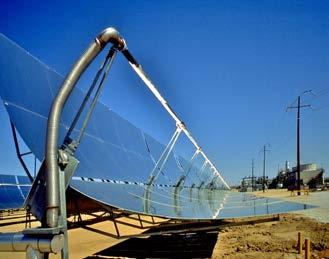
Solar energy has great potential for the future. Radiant energy from the sun is free and its supplies are unlimited. It cannot be controlled by any one nation or industry. The electricity generated by photovoltaics does not pollute the environment; however, the manufacturing of the PV cell does have an environmental impact. As we improve the technology to harness the sun’s enormous power, we can work toward a sustainable energy future.
Solar electric systems are safe, clean, and quiet to operate.
Solar systems are highly reliable.
Solar systems require very little maintenance.
Solar systems are cost-effective in remote areas and for some residential and commercial applications.
Solar systems are flexible and can be expanded to meet increasing electrical needs for homes and businesses.
Solar systems can provide independence from the grid or backup during outages.
The fuel is renewable and free and domestically produced.
Harnessing solar energy spurs economic development.
Using solar energy to generate electricity produces no greenhouse gases.
PV systems are not well suited for energy-intensive uses such as heating.
Grid-connected systems are often expensive, except in areas with high electricity rates where local incentives are offered.
We cannot harness solar energy at night.
To be used around the clock, solar systems require battery or thermal storage.
Utility scale systems require a large amount of land.
The highest solar concentration is found in areas far from population centers.
Systems are affected by shading, cloudy weather, and dirt accumulation.
Large utility-scale concentrated solar systems require large amounts of water in areas where there is very little water.
Due to the cost per kilowatt-hour to generate electricity from PV, power companies often opt for cheaper sources for generation.
The process to make some solar electric technologies can have harmful effects on the environment.
CSP facilities can affect wildlife in an area.
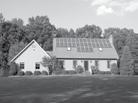



? Question
What happens to the sun’s radiant energy when it comes in contact with a black can or a shiny can?
Hypothesis
In your science notebook, write your hypothesis in an “If…then…because…” format.
! Caution
Do not look directly at the sun or its reflection; doing so can be harmful to your eyesight.
Materials
1 Set of radiation cans (one black and one shiny)
2 Thermometers
1 Beaker
Room temperature water
Light source (sunny day or bright artificial light)
Timer
Procedure
1. Put thermometers into the empty black and shiny cans and replace the lids. Position the thermometers so they are not touching the bottoms of the cans. Record the starting temperature of both cans.
2. Place the cans in a sunny place or under the light source. Record the temperature every minute for fifteen minutes using the data table on the next page.
3. Calculate the change in temperature for each can and record it in the DT column of the data table.
4. Remove the cans from the direct light. Take the lid off of each can and allow the air inside to return to room temperature.
5. Fill both cans with 150 mL of room temperature water and record the temperatures.
6. Place the cans under the same light source. Record the temperature every minute for 15 minutes.
7. Calculate the change in temperature for each can and record it in the DT column of the data table.
1. What have you learned about converting radiant energy into heat? How does that relate to reflection and absorption of radiant energy in the black and shiny cans?
2. Compare the results of measuring temperature change in cans with air and cans with water. What did you notice? Use data to explain what happened in each trial.
3. What color should a solar water heater be and why? Use data to support your answer.
Use or re-create the tables below in your science notebook for your data.
What effect do reflectors have on the amount of solar radiation collected?
In your science notebook, write your hypothesis in an “If…then…because…” format.
! Caution
Do not look directly at the sun or its reflection; doing so can be harmful to your eyesight.
1 Set of radiation cans (one black and one shiny)
Clay
2 Thermometers
Cold water
1 Beaker
Light source (sunny day or bright artificial light)
Ruler
Group B—2 Concave mirrors
Group C—4 Concave mirrors
Group D—2 Flat mirrors
Group E—4 Flat mirrors
Procedure
1. Fill the silver and black radiation cans with 150 mL of cold water.
2. Put a thermometer into each can and position them so the thermometers are in the water but not touching the bottoms of the cans. Replace the lids. Record the temperature of the water on your data table in the starting temperature column.
3. Place the cans in the light source. If using a lamp, make sure all cans are equidistant from the lamp.
4. Position the mirrors for your group using the following instructions:
Group A: The control—cans without mirrors.
Group B: Position one concave mirror behind each can so that the mirrors focus sunlight onto the cans. The mirrors should be about seven centimeters (7 cm) from the outside edge of the can. Use pieces of clay to hold the mirrors in the correct position.
Group C: Position two concave mirrors behind each can as described above.
Group D: Position one flat mirror behind each can as described above.
Group E: Position two flat mirrors behind each can as described above.
5. Record the temperatures of the water in your group’s cans every minute for 15 minutes.
6. Calculate the change in temperature and record it in the DT column on the data table in your science notebook.
7. Share your data with the other groups and record their findings in your data table in your science notebook.
1. Compare and contrast how the shape of the mirror and the color of the container influence the amount of heat energy absorbed. Use data to support your answer.
2. How does the solar industry use concentrated solar power to produce electricity?
Use or re-create the table below in your science notebook for your data. Put your initials by the cans you are responsible for and record your data. When you are done, share your data with the class, and fill in the rest of the data based on other groups’ results.
Black Can with no mirror
Shiny Can with no mirror
Black Can with one concave mirror
Shiny Can with one concave mirror
Black Can with two concave mirrors
Shiny Can with two concave mirrors
Black Can with one flat mirror
Shiny Can with one flat mirror
Black Can with two flat mirrors
Use this guide to place the mirror 7 cm away from the can.
Can
7cm
What happens when colored water evaporates?
Hypothesis
In your science notebook, write your hypothesis in an “If…then…because…” format.
Materials
1 Large container (e.g., cake pan, glass bowl, disposable aluminum pan)
1 - 100 mL Beaker (or small glass bowl shorter than the depth of your larger dish)
1 Marble
Clear plastic wrap
Large rubber band
Water
Food coloring
Sunny day or bright light source
Procedure
1. Measure and pour 50 mL of water into the large container.
2. Add four (4) drops of food coloring to the water and mix. Record the color of the water.
3. Set the small beaker/bowl in the center of the large plastic container. Weigh it down if it is floating.
4. Place the plastic wrap over the top of the large plastic container leaving a depression in the center over the small beaker/bowl. Secure the plastic wrap with the rubber band, making sure no air is able to flow in or out of the model.
5. Place a marble in the center of the plastic wrap over the small beaker/bowl.
6. Place the container in the full sun, or bright light.
7. Observe the container after 30 minutes.
Data
Record your observations using pictures and words in your science notebook.
Conclusions
1. What did you observe in the center small beaker/bowl?
2. Draw and label the solar distiller. Explain the processes of evaporation and condensation in the solar distiller.
3. Draw and label Earth’s natural water cycle. Explain the processes of evaporation and condensation in the water cycle. Compare and contrast how they are the same and how they are different.
Extension
Test a variety of liquids to find out which ones contain water.
Plastic Wrap
Rubber Band
? Question
How does changing the amount of radiant energy reaching the solar panel affect the panel’s electrical output?
Hypothesis
In your science notebook, write your hypothesis in an “If…then…because…” format.
Materials
1 PV module
1 Motor
1 Fan
Paper
Bright light source
Procedure
1. Attach the motor to the PV module by removing the screws on the posts of the PV module, sliding one connector from the motor onto each post, then reconnecting the screws.
2. Attach the fan to the stem of the motor so that you can see the motion of the motor.
3. Place the module under a bright light source. Record your observations in your science notebook.
4. Cover ¼, then ½, then ¾ of the module using a piece of paper and observe what happens to the spinning of the fan. Record your observations in your science notebook.
5. Hold the PV module at different angles to the sun. Estimate the angles you use. Observe and record your observations.
6. Cover part of the PV module and change its angle. Observe and record your observations.
7. Observe and note the direction of the spin of the fan. Remove the wires from the PV module posts and connect them to the opposite posts. Observe and record your observations.
Conclusions
1. What have you learned about PV cells and their ability to convert radiant energy into electricity?
2. How does changing the area of sunlight exposure on the PV module affect the amount of electricity produced?
3. How does changing the angle of the PV module to the sunlight affect the amount of electricity produced?
4. Which angle and exposure of the PV module produced the most electricity?
5. Explain the results of reversing the wires on the PV module posts.

Does temperature affect the rate at which UV beads change colors?
UV stands for ultraviolet light, a type of electromagnetic radiation that travels in a wave-like pattern. UV light is found within sunlight but is invisible. You are probably aware of the effects of UV radiation because you wear sunscreen and sunglasses to protect you from it. UV light produces chemical reactions that can cause a substance to glow or fluoresce, or your skin to burn or tan. It also causes the formation of Vitamin D, an essential vitamin for humans and other organisms. A good amount of harmful UV radiation gets blocked by the ozone layer, but the little amounts that get through will lead to these chemical changes. UV beads contain special color-changing pigments that are sensitive to UV light from the sun and other sources. The reaction in these beads is also extended with a change in temperature. Does your skin have the same response?
In your science notebook, write your hypothesis in an “If…then…because…” format.
4 Foam cups
UV beads
4 Thermometers
Ice—a few cubes
Beaker (250 mL or 100 mL)
Permanent marker
Timer, clock, or watch with second hand
Sunny day
Hot, cold, and room temperature water
1. Allow the UV beads to sit in sunlight for a brief moment.
2. Gather four UV beads of the same color.
3. Use the marker to label each of the cups as follows:
Cup 1—room temperature water
Cup 2—hot water
Cup 3—ice water
Cup 4—room temperature water
4. Add 1 UV bead to each cup.
5. Add 100 mL of room temperature water to Cup 1.
6. Add 100 mL of hot water to Cup 2.
7. Add ice and 100 mL water to Cup 3.
8. Add 100 mL of room temperature water to Cup 4. Cup 1 will remain indoors as the control.
9. Take a temperature reading of each of the cups and record it on the data chart.
10. Record the color of the beads.
11. Take Cups 2, 3, and 4 outside into the sunlight for one minute.
12. Record your observations after one minute of UV exposure and be as specific with the color observations as you can.
13. Return to your classroom and wait one minute. Record your observations in the data chart. Compare the beads you took outside to the bead you left in the classroom. Record your observations.
14. Wait two more minutes and compare the beads again. Note the color and record your observations.
Use the table below or re-create it in your science notebook to record your data.
1. What happened to the beads when exposed to UV light outside?
2. What happened to the beads one minute after returning back inside?
3. Which temperature of water affected the beads the most? How?
4. Did the water temperature affect the rate at which the UV beads lost their color?
Test multiple colors of beads at the same time. Do the beads change colors at different rates?
What will happen when the solar balloon is filled with air and taken outside on a sunny day?
Hypothesis
In your science notebook, write your hypothesis in an “If…then…because…” format. Be sure to support or explain your hypothesis using the concepts you explored in previous activities. Incorporate at least five words from the word bank below in your explanation. Circle the words you chose to use!
Solar balloon
Fishing line or lightweight string
Sunny day
Word Bank
absorbs
air
converts
gas
heat
light
radiant energy
reflection
transforms
thermal energy
Procedure
1. Take the solar balloon outside. Tie one end of the balloon and fill it with air. When the balloon is full, tie the open end closed. Tie fishing line or lightweight string to the balloon and let it sit in the sunlight. Observe what happens. Record your observations.
Conclusion
1. Do you support or reject your hypothesis? Explain why using evidence from your observations. Use words from the word bank above to explain what happened to the balloon.
How does the design of a solar oven affect the transformation of radiant energy to thermal energy?
Hypothesis
In your science notebook, write your hypothesis in an “If…then…because…” format.
1 Small pizza box or cardboard box
Plastic wrap or transparency sheet
Aluminum foil
1 Wooden skewer (12”-18”)
Marker
Scissors
Ruler
Masking tape
1 Paper plate
Black construction paper
Thermometer
Food to cook
Various materials provided by your teacher
1. Read over the general solar oven directions below and look at the materials provided by your teacher.
2. List all of the possible variables you could change in your solar oven design.
3. In your science notebook, or using the next page, sketch possible designs. Discuss with your group all of your different ideas. Choose one solar oven design to build.
4. Gather the materials you need.
5. Build your solar oven and test its efficiency using the oven thermometer.
6. Make any needed design changes that will enable your solar oven to cook food efficiently.
1. On the top of the pizza box, use your marker to draw a square with edges spaced 1” from all sides of the box.
2. Use scissors to cut along the sides and front edge of the lid, leaving the fourth side along the box’s hinge uncut.
3. Tape aluminum foil to the inside surface of the new flap you just cut, shiny side visible. This is to reflect sunlight into the box. Smooth out any wrinkles that might occur.
4. Tape plastic wrap to the original box flap so that it covers the hole you cut into the flap. Seal all four of the edges with tape.
5. Tape black construction paper to the bottom inside of the box. This will help absorb the incoming sunlight.
6. Cover any air leaks around the box edges with tape, making sure that the box can still be opened to place food inside or remove it later.
7. Go outside in the sunlight and place the solar oven on a level flat surface.
8. Place food items on a paper plate and place it inside the oven. Put the oven thermometer inside the oven where you will be able to see it without moving the oven.
9. Tape one end of a wooden skewer to the reflector lid, attach the other end to the box to adjust reflector.
10. Let the food cook and periodically check the reflector angle to make sure sunlight is getting inside the oven.
1. What factors contributed to the successful cooking of the food?
2. What effect did changing the variable(s) have on converting radiant energy to thermal energy? How could you improve your design?
3. What are the practical applications where solar ovens could be used?
A solar oven needs to let radiant energy in, convert that radiant energy to thermal energy, and keep the thermal energy inside to cook the food. Use this page to brainstorm solar oven design possibilities.
Brainstorm possible solar oven designs. Label the materials you will use and explain why.
Share your design with the other members of your group. What is similar? What is different?
Choose one design that your group will use. Sketch the design here. Label the materials you will use and explain why you think this is the best design.
You have been commissioned by The National Energy Education Development Project to design a home using passive and active solar design principles. You will be expected to present the solar home design to potential buyers (your peers). You will need to explain what the solar features are, how they work, and why they are beneficial to the energy efficiency of your home.
Sketch at least two designs, and choose one to develop completely.
Draw the design on graph paper.
Indicate cardinal directions (north, south, east, west) on your drawing.
Label all components including windows, doors, type of solar systems, and any other information that will help explain your design.
Include landscaping plans and label those on your drawing as well.
Write a paragraph about your house design explaining the choices you made.
Use the topic organizer on page 22 to develop a short presentation about your design.
Important Information
Graphics Needed
Topic
Additional Information Needed
Design of Presentation
active solar home using specialized pumps, fans, and/or equipment to move heated air or power a home concentrating solar power system technologies that focus the energy from the sun onto one smaller area creating high temperatures that can produce electricity
dish/engine system a type of solar collector that uses satellite-like dishes and an engine to track and focus the sun’s rays to a focus point
Fresnel lens a lens designed to capture light using concentric circles in sections on its surface greenhouse effect the trapping of energy from the sun by the atmosphere, due to the presence of certain gases; the atmosphere acts like a greenhouse grid the layout of the system of electrical distribution lines heat exchanger any device that transfers heat from one fluid to another, or to the environment
heliostat a sun-seeking or tracking mirror that changes its direction to follow the sun’s rays hybrid solar system using a combination of active and passive solar designs to heat and power a home; see active solar home; see passive solar home
kilowatt a unit of power, usually used for electric power or energy consumption; 1,000 watts
linear concentrating system a system of mirrors in a line that focus sunlight onto receivers that carry liquid to a heat exchanger
linear Fresnel reflector system a system using groups of flat mirrors to focus sunlight onto a receiver; lenses capture light at angles to better focus light onto the receiver; see Fresnel lens
megawatt unit of electric power equal to 1,000 kilowatts or one million watts nuclear fusion when the nuclei of atoms are combined or “fused” together; the sun combines the nuclei of hydrogen atoms into helium atoms during fusion nuclei more than one nucleus; nuclei are the centers of atoms that hold protons and neutrons
parabolic trough system a type of solar collector that has a parabolic shaped reflector to focus radiant energy passive solar home a means of capturing, storing, and using heat from the sun without using specialized equipment photovoltaic from the words photo and volt; means energy from light; see photovoltaic cell photovoltaic cell a device, usually made from silicon, which converts some of the energy from light (radiant energy) into electric energy; another name for a solar cell radiant energy any form of energy radiating from a source in electromagnetic waves renewable fuels that can be easily made or replenished; we can never use up renewable fuels silicon an element commonly found on Earth that is frequently used for semiconductors, PV cells, and electric equipment
solar collector an item, like a car or greenhouse, that absorbs radiant energy from the sun and traps it within solar power tower a device that focuses solar energy on a single spot using reflection, producing high temperatures that can create steam to turn turbines
space heating heating the interior of a building or home thermal energy the energy contained within a substance due to the random motion of atoms and molecules of the material
utility-scale term used to describe an electric generation device that provides megawatts of power for distribution watt a unit of power, usually for electric measurments; describes the rate at which work is done or energy is used
The NEED Youth Energy Conference and Awards gives students more opportunities to learn about energy and to explore energy in STEM (science, technology, engineering, and math). The annual June conference has students from across the country working in groups on an Energy Challenge designed to stretch their minds and energy knowledge. The conference culminates with the Youth Awards Cenermony recognizing student work throughout the year and during the conference.
For More Info: www.youthenergyconference.org
All NEED schools have outstanding classroom-based programs in which students learn about energy. Does your school have student leaders who extend these activities into their communities? To recognize outstanding achievement and reward student leadership, The NEED Project conducts the National Youth Awards Program for Energy Achievement.
Share Your Energy Outreach with The NEED Network! This program combines academic competition with recognition to acknowledge everyone involved in NEED during the year—and to recognize those who achieve excellence in energy education in their schools and communities.
What’s involved?
Students and teachers set goals and objectives and keep a record of their activities. Students create a digital project to submit for judging. In April, digital projects are uploaded to the online submission site.
Check out:
www.NEED.org/need-students/youth-awards/ for more application and program information, previous winners, and photos of past events.
Looking for some fun energy activities? There are plenty of fun games, puzzles, and activities available at www.NEED.org/need-students/games-puzzles-activities/.


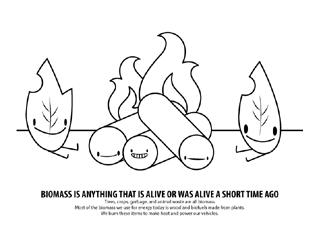
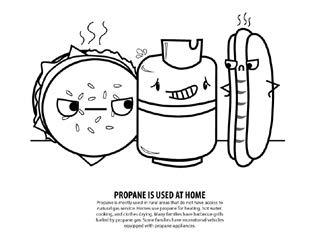
Windissimplyairinmotion.ItiscausedbytheunevenheatingoftheEarth’ssurfacebyradiantenergy fromthesun.SincetheEarth’ssurfaceismadeofverydi erenttypesoflandandwater,itabsorbsthesun’s energyatdi erentrates.Theheavier,denser,coolairoverthewater owsintotakeitsplace,creatingwind. Inthesameway,theatmosphericwindsthatcircletheEartharecreatedbecausethelandneartheEquator isheatedmorebythesunthanlandneartheNorthandSouthPoles.
Biomassisanyorganicmatterthatcanbeusedasanenergysource.Wood,crops,andyardandanimal wasteareexamplesofbiomass.Peoplehaveusedbiomasslongerthananyotherenergysource. Forthousandsofyears,peoplehaveburnedwoodtoheattheirhomesandcooktheirfood.
Foldinalongdottedlines, crease,andunfold
Foldinalongdottedlines, crease,andunfold

Foldinalongdottedlines, crease,andunfold
UnfoldStep4on thetophalf
Foldinalongdottedlines, tomeetthecenter
Foldinalongdottedlines, tomeetthecenter
Foldinalongdottedlines, crease,andunfold
Open,Bringthetopdown andpresspaper at
Foldinthecreases
Foldforwardalongthedotted linesandcrease Repeatonothersides
Openthepocketand atten Repeatonallfoursides
Folddownalongdottedlines Repeatonallfoursides
Makethe2diagonalfoldsasindicatedandDONE!
Adapt2 Solutions
Alaska Electric Light & Power Company
American Electric Power Foundation
American Fuel & Petrochemical Manufacturers
Arizona Sustainability Alliance
Armstrong Energy Corporation
Robert L. Bayless, Producer, LLC
Baltimore Gas & Electric
Berkshire Gas - Avangrid
BG Group/Shell
BP America Inc.
Blue Grass Energy
Bob Moran Charitable Giving Fund
Boys and Girls Club of Carson (CA)
Buckeye Supplies
Cape Light Compact–Massachusetts
Central Alabama Electric Cooperative
CLEAResult
Clover Park School District
Clovis Uni ed School District
Colonial Pipeline
ComEd
Con uence
ConocoPhillips
Constellation
Delmarva Power
Dominion Energy, Inc.
Dominion Energy Charitable Foundation
DonorsChoose
Duke Energy
Duke Energy Foundation
East Baton Rouge Parish Schools
East Kentucky Power
EcoCentricNow
EDP Renewables
EduCon Educational Consulting
Enel Green Power North America
Eugene Water and Electric Board
Eversource
Exelon
Exelon Foundation
Exelon Generation
Foundation for Environmental Education
FPL
The Franklin Institute
George Mason University – Environmental Science and Policy
Georgia Power
Gerald Harrington, Geologist
Government of Thailand–Energy Ministry
Green Power EMC
Greenwired, Inc.
Guilford County Schools–North Carolina Honeywell
Houston LULAC National Education Service Centers
Iowa Governor’s STEM Advisory CouncilScale Up
Illinois Clean Energy Community Foundation
Illinois International Brotherhood of Electrical Workers Renewable Energy Fund
Illinois Institute of Technology
Independent Petroleum Association of New Mexico
Jackson Energy
James Madison University
Kansas Corporation Energy Commission
Kansas Energy Program – K-State Engineering Extension
Kentucky O ce of Energy Policy
Kentucky Environmental Education Council
Kentucky Power–An AEP Company
League of United Latin American Citizens –National Educational Service Centers Leidos
LES – Lincoln Electric System
Liberty Utilities
Linn County Rural Electric Cooperative
Llano Land and Exploration
Louisiana State Energy O ce
Louisiana State University – Agricultural Center
Mercedes-Benz USA
Minneapolis Public Schools
Mississippi Development Authority–Energy Division
Motus Experiential
National Fuel
National Grid
National Hydropower Association
National Ocean Industries Association
National Renewable Energy Laboratory
NC Green Power
Nebraskans for Solar
NextEra Energy Resources
Nicor Gas
NCi – Northeast Construction
North Shore Gas
O shore Technology Conference
Ohio Energy Project
Oklahoma Gas and Electric Energy Corporation
Omaha Public Power District
Paci c Gas and Electric Company
PECO
Peoples Gas
Pepco
Performance Services, Inc.
Permian Basin Petroleum Museum
Phillips 66
PNM
PowerSouth Energy Cooperative
Providence Public Schools
Quarto Publishing Group
Prince George’s County O ce of Sustainable Energy (MD)
Renewable Energy Alaska Project
Rhoades Energy
Rhode Island O ce of Energy Resources
Rhode Island Energy E ciency and Resource Management Council
Salal Foundation/Salal Credit Union
Salt River Project
Salt River Rural Electric Cooperative
C.T. Seaver Trust
Secure Futures, LLC
Shell
Shell Carson
Shell Chemical
Shell Deer Park
Singapore Ministry of Education
SMECO
SMUD
Society of Petroleum Engineers
South Carolina Energy O ce
SunTribe Solar
Tri-State Generation and Transmission
TXU Energy
United Way of Greater Philadelphia and Southern New Jersey
Unitil
University of Kentucky
University of Louisville
University of Maine
University of North Carolina
University of Rhode Island
University of Tennessee
University of Texas Permian Basin
University of Wisconsin – Platteville
U.S. Department of Energy
U.S. Department of Energy–O ce of Energy E ciency and Renewable Energy
U.S. Department of Energy - Water Power Technologies O ce
U.S. Department of Energy–Wind for Schools
U.S. Energy Information Administration
United States Virgin Islands Energy O ce
We Care Solar